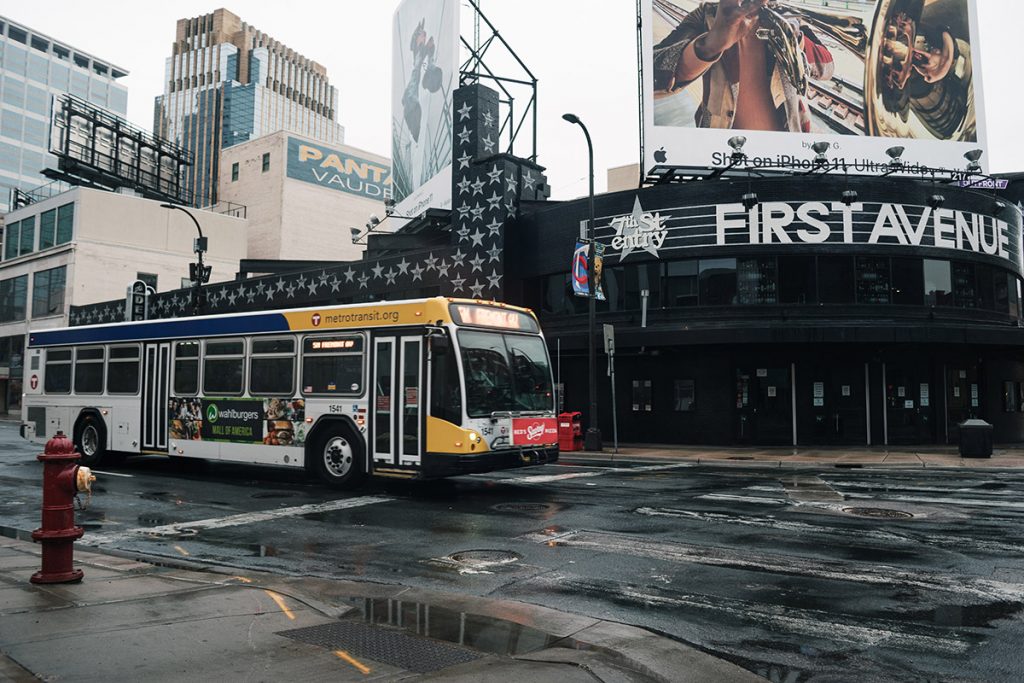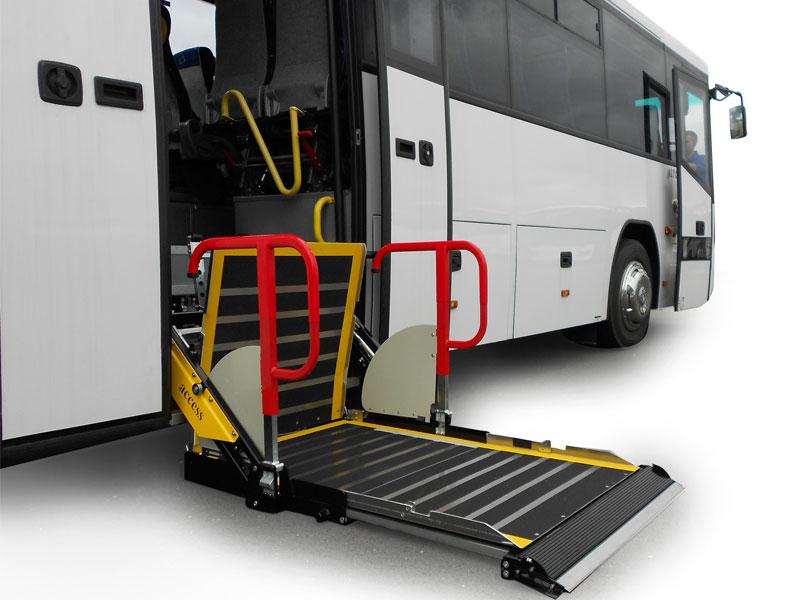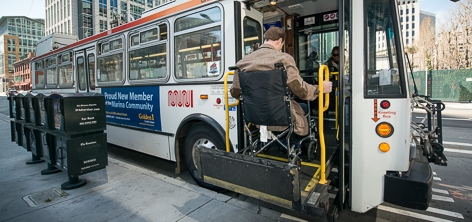Many people with disabilities do not drive. This may be for a variety of reasons – some may not be able to drive; some may have financial constraints; and some may not be comfortable with operating a vehicle or driving on busy streets. Myself, I have only driven a few times since I became disabled, due to financial restrictions as well as PTSD symptoms that flare up when I’m on the road (my disability – spinal cord injury – was caused by a car accident).
Those of us who do not drive often use some form of public transportation to get around. If you’re newly disabled, or new to public transportation, the idea of using these services might seem daunting. You may have questions such as: Do all buses have ramps or lifts? Are all bus stops accessible? In this article I’ll answer these questions and more to the best of my ability and give you web resources to help answer any questions not covered here.
A bit of background regarding my public transit experience: For several years I served on my local transit agency’s citizen’s advisory board. This was a volunteer position. Also on the board were representatives from local disability agencies, including the blind and low vision center; a dialysis center; and a day center for those with developmental disabilities. While representation of these groups was, of course, needed, as far as I knew I was the only member of the board that actually had both a disability as well as experience using public transportation as a disabled person. Needless to say, I felt both my presence and my direct experiences were important additions. I have also worked in disabled student services at my local university, where part of my job was to help students and guests find transportation. I’m not located in a big city, so finding methods of transportation that both worked and were timely was often an issue.
I have used buses and paratransit as a disabled person in the U.S. for more than fifteen years. I’d like to pass on some things I’ve learned as a passenger, board member, and someone who is passionate about the mobility of disabled people – because being able to get around can not only expand your range of opportunities in life, but it also helps keep you healthy by allowing you to get the medical care you may need.
A good rule of thumb for any disabled person when trying something new is to call ahead. While there are federal rules, regulations, and guidelines regarding public transportation set by the Americans with Disabilities Act, there are still circumstances that might affect your transportation needs. If you have concerns about using buses or paratransit as a person with a disability, oftentimes a phone call or two can help clarify things.
Unfortunately, not all transit agencies or personnel follow all the rules perfectly, often due to ignorance of the law, discriminatory attitudes, and/or simple apathy. It’s important to know your rights as a passenger. There are too many rules for me to cover all of them, but I will provide links where you can study the regulations and discover which ones apply to you and your mobility devices if you wish.
I have used buses and paratransit as a disabled person in the U.S. for more than fifteen years. I’d like to pass on some things I’ve learned as a passenger, board member, and someone who is passionate about the mobility of disabled people

Getting On the Bus
According to the Federal Transit Authority, as of 2013 “[n]early 100 percent of transit buses…were reported to be accessible[.]”(1) Buses will have either ramps or lifts.
People with disabilities often pay reduced fare; some transit systems require you to get a special ID card from them in order to take advantage of this.
Before you even start your trip, call ahead to make sure all of the stops you plan to use are accessible. Some things that can make a stop inaccessible include lack of sufficient room to deploy a ramp or lift; very uneven ground where only one side of the lift or ramp can touch the ground (such as on a steep hill); or no sidewalk (the terrain may be difficult or impossible to wheel though).
Going up on a high lift can be a bit nerve-wracking the first few times – there you are, stuck in your chair, and you’re being lifted higher than you may have ever been, sometimes higher than people’s heads. For me it can be a vulnerable experience, especially when I first started using transit. But the nerves start to ease the more times you are lifted. Remember to always lock your brakes, or if you don’t use brakes, get a firm hold on your wheels or the handrails. If you’re using a ramp and find it too steep, ask the driver if they can lower the front end of the bus (the bus may or may not have this capacity); alternatively, drivers are required to help push a manual wheelchair user up a steep ramp if asked.(2)
Please note that some ramps and/or lifts may have a weight capacity of no more than 600 lbs. (272kg) – take this into consideration if you use a heavy wheelchair or scooter and are a large person.
If you are trying to board a bus but cannot because the lift or ramp is broken, the bus driver is required to call for an alternate mode of transportation for you if the next bus is more than 30 minutes away. If the ramp or lift is broken, the driver cannot simply leave you at the stop if you’re going to have to wait more than 30 minutes for the next bus to arrive.(3) And if you ask the driver when the next bus is arriving, “I don’t know” is not, by law, an acceptable answer. They need to radio in and ask for the next scheduled time.(4)
When you get on the bus, the driver will likely secure your chair, but is not legally required to (unless you request it).(5) In my experience, different drivers have different levels of proficiency with this task. It’s important for you to direct drivers if they need help finding a secure location on your chair to attach the straps (usually part of the frame); it’s also important for you to speak up if you feel the location they attach the straps to doesn’t seem secure to you — or if any part of your securement doesn’t feel or look secure enough. You may also be offered a seatbelt, but wearing one is not required unless everyone on the bus has to wear one.(6)
Tell the driver where you plan to deboard. This way, the driver can position the bus so as to deploy the ramp or lift. Signal your stop by pushing the button or ringing the bell to remind them.

Going up on a high lift can be a bit nerve-wracking the first few times – there you are, stuck in your chair, and you’re being lifted higher than you may have ever been, sometimes higher than people’s heads. For me it can be a vulnerable experience, especially when I first started using transit.
Passengers Making Room
Currently, the FTA states: “[R]equests by drivers that other passengers move from priority seats will assist in making transportation genuinely accessible for passengers with disabilities.” However, “[D]rivers or other personnel on vehicles [are] not…required to enforce a request for someone to move from a priority seat (e.g., by physically removing a recalcitrant passenger or parking the bus and calling the police.) This ‘ask, don’t tell’ approach should help to avoid confrontations and disruptions of service…The rule would not impose a uniform procedure; each transit system may devise a means best suited to its operations to carry out the requirement.”(7) Basically, a driver can ask people to move from their seats, but if they won’t, the driver is not expected to add “bouncer” to their job description.
For what it’s worth, in my two decades as a chair user and bus rider I have never experienced someone refusing to move for me. Have I encountered people who make faces and seem put out, or people who make comments under their breath (especially when they’re sitting in the back)? Yes, I have, but in my experience this is rare. This seems to have a higher chance of happening during busy times when the bus is rather full and/or running late. When I was first disabled it was hard for me to deal with negative reactions like this – I felt embarrassed and like a burden.
It took a few years of growing confidence as well as disability advocacy research for me to not feel ashamed about riding a busy bus; about having people move for me; and about the few minutes it takes for the driver to secure me and my chair. I stopped feeling bad and started feeling angry whenever I sensed people’s negativity. One time many years ago when a driver was securing me I heard a certain impatient rider say (from the back, of course), “Oh, come on!” I turned around in my chair and said, “So sorry if me being in a wheelchair ruins your day.” You could hear a pin drop. These days I am less prone to anger and more prone to assertiveness; now my response is a more measured, “I didn’t ask to be in this wheelchair, and I have just as much of a right to ride the bus as you do.” It has the same effect – pin-drop silence – without raising my own stress levels too much.
Remember, you have just as much of a right to ride the bus as anyone else. Just like the other passengers, you have errands to do, or work to go to, or appointments to make. The bus is there for residents of your area to use, and you are one of those residents.
Unfortunately, it’s not only the passengers who may give you problems. You might run into the occasional driver who tries to deny you service or makes you feel uncomfortable. I was waiting at a stop one day and the bus pulled up; after the driver had opened the door he said to me, “Sorry, there’s no room.” I looked into the windows of the bus and replied, “I don’t see anybody standing, they can stand and make room for me.” I didn’t know at the time that drivers could not force people to move from their seats. However, drivers are required to at least ask that people move – and this particular driver made it obvious to me that he was not happy about doing even that. Technically, it was a violation of the FTA’s rules for the driver to tell me that I could not board the bus without him even asking first if people would move. This, and the driver’s observable attitude of acting like I was being a burden to him, constituted discrimination by law. Back then I was ignorant of the law, and simply labeled him a jerk; today, I know that I would have been within my rights to file an ADA complaint with the Department of Justice if I so chose (you can do so here).

Have I encountered people who make faces and seem put out, or people who make comments under their breath (especially when they’re sitting in the back)? Yes, I have, but in my experience this is rare.
Service Animals
Service dogs as well as other service animals are permitted on public transit. The ADA was amended in 2010 and it now limits the definition of service animals to dogs and miniature horses — but transit entities were not affected by this amendment.(8) Emotional support animals are not protected by FTA law, but your local transit authority may permit them if they so choose.
Drivers cannot require documentation or “proof” regarding your service animal. They are only allowed to ask two questions: 1) Is the animal a service animal? and 2) What tasks does the animal do for you? (The law limiting inquires to these two questions applies everywhere you go, not just public transit; additionally, no one is allowed to ask you what your disability is.)
Personal Care Attendants: Do They Ride For Free?
Whether or not Personal Care Attendants (PCAs) pay a fare to ride the bus is up to the transit provider. Transit providers are not required by law to allow PCAs to ride the bus for free. This is different from paratransit, which is required to let your PCAs ride for free.(9)
In part II of this article, I will be discussing the ins and outs of using the paratransit system, a “door-to-door” service that picks you up from your house and takes you where you want to go (within their service area). Paratransit is for people with disabilities who cannot use the fixed-route bus for whatever reason – and there can be several reasons, which I will discuss. Paratransit is usually more expensive and requires you to go through an eligibility process. There’s a bit of work you need to do to set it up for yourself, but if you find it difficult or impossible to use the bus in your area, paratransit may be a good transportation option for you.
Resources
Rider’s Guide to Public Transit for People With Disabilities – A comprehensive PDF guide that includes many different disabilities as well as more information on your ADA rights.
Riding with your wheelchair – Saan, who uses both a powerchair and a manual one, gives some great bus-riding tips. (6 min.)
Wheelchair on a Bus? – How to use Public Transportation vlog – A manual chair user rides both a bus and rapid transit. (5 min.)
Riding the Bus Using a Wheelchair – A video from the Green Bay Metro Transit system that features a powerchair user. (2 min.)
How to File an ADA Complaint – This page includes the option to file your complaint electronically.
References
- Federal Transit Authority. (2015). Americans With Disabilities Act (ADA): Guidance. FTA C 4710.1. Section 4.1. Retrieved from: https://www.transit.dot.gov/sites/fta.dot.gov/files/docs/Final_FTA_ADA_Circular_C_4710.1.pdf
- Meeting the Challenge, Inc. The Riders’ Guide to Public Transit for People with Disabilities (Fixed Route and ADA Complementary Paratransit). Transit Access Project. Retrieved from: https://www.nationalmssociety.org/NationalMSSociety/media/MSNationalFiles/Documents/ridersguide.pdf
- Federal Transit Authority. (2015). Americans With Disabilities Act (ADA): Guidance. FTA C 4710.1. Section 6.2.2. Retrieved from: https://www.transit.dot.gov/sites/fta.dot.gov/files/docs/Final_FTA_ADA_Circular_C_4710.1.pdf
- Federal Transit Authority. (2015). Americans With Disabilities Act (ADA): Guidance. FTA C 4710.1. Section 6.2.1. Retrieved from: https://www.transit.dot.gov/sites/fta.dot.gov/files/docs/Final_FTA_ADA_Circular_C_4710.1.pdf
- Federal Transit Authority. (2022.) Frequently Asked Questions from FTA Grantees Regarding Coronavirus Disease 2019 (COVID-19). Retrieved from: https://www.transit.dot.gov/frequently-asked-questions-fta-grantees-regarding-coronavirus-disease-2019-covid-19#COVID-19Civil
- Federal Transit Authority. (2015). Americans With Disabilities Act (ADA): Guidance. FTA C 4710.1. Section 2.4.4. Retrieved from: https://www.transit.dot.gov/sites/fta.dot.gov/files/docs/Final_FTA_ADA_Circular_C_4710.1.pdf
- Transportation for Individuals with Disabilities –Detectable Warnings, Standees on Lifts, Equivalent Facilitation, Priority Seating, Rail Car Acquisition, RIN 2105-AB53, pg. 17. (1993.) Retrieved from: https://www.transit.dot.gov/regulations-and-guidance/civil-rights-ada/transportation-individuals-disabilities-detectable
- Federal Transit Authority. (2015). Americans With Disabilities Act (ADA): Guidance. FTA C 4710.1. Section 2.8. Retrieved from: https://www.transit.dot.gov/sites/fta.dot.gov/files/docs/Final_FTA_ADA_Circular_C_4710.1.pdf
- Federal Transit Authority. “May Personal Care Attendants (PCAs) ride for free on complementary paratransit and fixed route?” (n.d.). Retrieved from: https://www.transit.dot.gov/may-personal-care-attendants-pcas-ride-free-complementary-paratransit-and-fixed-route


One Response